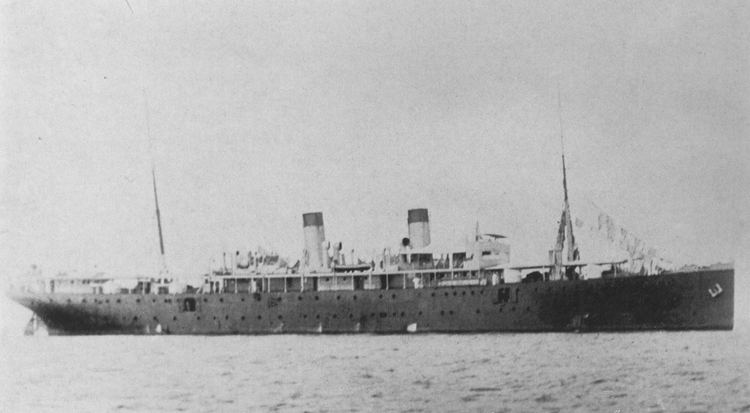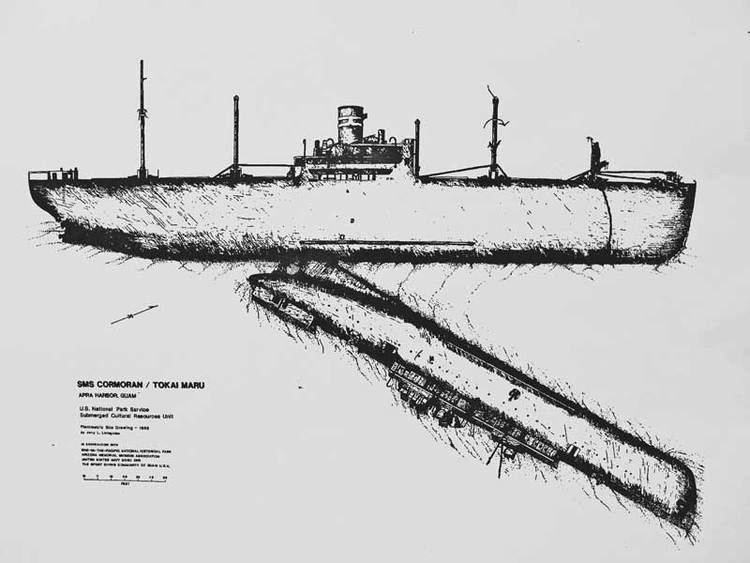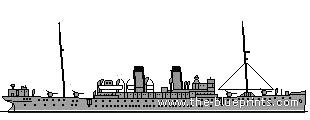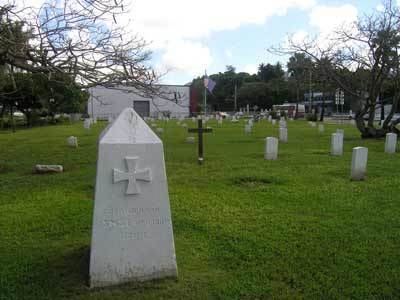Namesake SMS Cormoran I Acquired captured by SMS Emden Weight 3,500 tons Year built 1909 Added to NRHP 4 April 1975 | Launched 1909 as SS Ryazan Length 104 m Area 400 m² Builder Schichau-Werke Nearest city Piti | |
 | ||
Name SMS Cormoran aka SMS Cormoran II Commissioned 10 August 1914 as SMS Cormoran II Fate scuttled at Apra Harbor, Guam on 7 April 1917 | ||
SMS Cormoran or SMS Cormoran II was built at the Schichau shipyard in Elbing, Imperial Germany in 1909 for the Russian merchant fleet and was named SS Ryazan (Rjasan or Rjäsan, from the Russian town of Ryazan). She was used by imperial Russia as a combination passenger, cargo and mail carrier on North Pacific routes.
Contents

History
The SS Ryazan was captured southeast of the Korean peninsula by the light cruiser SMS Emden on 4 August 1914 as the first prize of World War I from the Russian empire. She was taken to Tsingtao in the German colony Kiautschou, where she was converted to an armed merchant raider. The new Cormoran replaced the original SMS Cormoran, a small shallow draft cruiser that had a long Imperial Navy career in the Pacific, having taken part in the events that brought Kiautschou into the German colonial empire in 1897–98. The old Cormoran was laid up at Tsingtao with serious maintenance issues and unable to go to sea, and her armaments were transferred to the captured merchant ship.

On 10 August 1914, the new Cormoran (or Cormoran II) left Tsingtao harbor and sailed through the South Pacific region, pursued by Japanese warships. On 14 December, she pulled into Apra Harbor in the U.S. Territory of Guam, having only 50 t (55 short tons) of coal remaining in her bunkers.

Due to strained diplomatic relations between the United States and Germany, plus the limited amount of coal stored at Guam, Governor William John Maxwell refused to supply Cormoran with more than a token amount of coal. He ordered the ship to leave within 24 hours or submit to detention. This created a standoff between the German crew and the Americans that lasted nearly two years, until Governor Maxwell was involuntarily placed on the sick list and replaced by his subordinate, William P. Cronan, who decided the German crew should be treated as guests of the United States. The Cormoran was not allowed to leave the harbor, but the crew were treated as friends, achieving a minor celebrity status on the island.

When the U.S. Congress declared war on Germany on 7 April 1917, Captain Adalbert Zuckschwerdt scuttled his ship rather than surrender her. This resulted in the "first shot" of the war between the U.S. and Imperial Germany. Sailors at Guam saw the German crew preparing to scuttle the ship and fired a shot across their bow in an effort to stop them. However, the German sailors continued to scuttle the vessel, and nine crew members perished (probably in the explosion that sank her). They were buried with full military honors in the naval cemetery at Agana. After the American sailors rescued and made prisoners the surviving Germans, Governor Cronan congratulated Captain Zuckschwerdt for the bravery of his men. The U.S. Navy later conducted a limited salvage operation and the ship's bell was recovered. It is exhibited at the U.S. Naval Academy Museum at Annapolis, Maryland. Other artifacts have been removed by divers over the years.

The German crew was sent to Fort Douglas, Utah, from where some were transferred to Fort McPherson, Georgia. All returned home on 7 October 1919, almost a year after the war's end.
The wreck of the SMS Cormoran II rests 110 ft (34 m) below the surface on her port side. A Japanese cargo ship, the Tokai Maru, sunk by the submarine USS Snapper, leans against her screw. This is one of the few places where divers can explore a World War I shipwreck next to a ship from World War II.
In 1975, the wreck was placed on the National Register of Historic Places. She was listed because of her association with World War I.
On 2 May 2016 a headstone was found in Westview cemetery in Atlanta Georgia bearing the name Kurt Moraht. The headstone is written completely in German, claiming the resting place of Oberleutnant Kurt Moraht of the SMS Cormoran, listing his birth as 28 April 1886 and death 24 December 1918, and lists the place of death as Fort MacPherson, Ga. Research has yet to reveal if Kurt Moraht was among the crew that scuttled the ship or if he was a prisoner who died at Ft. MacPherson.
